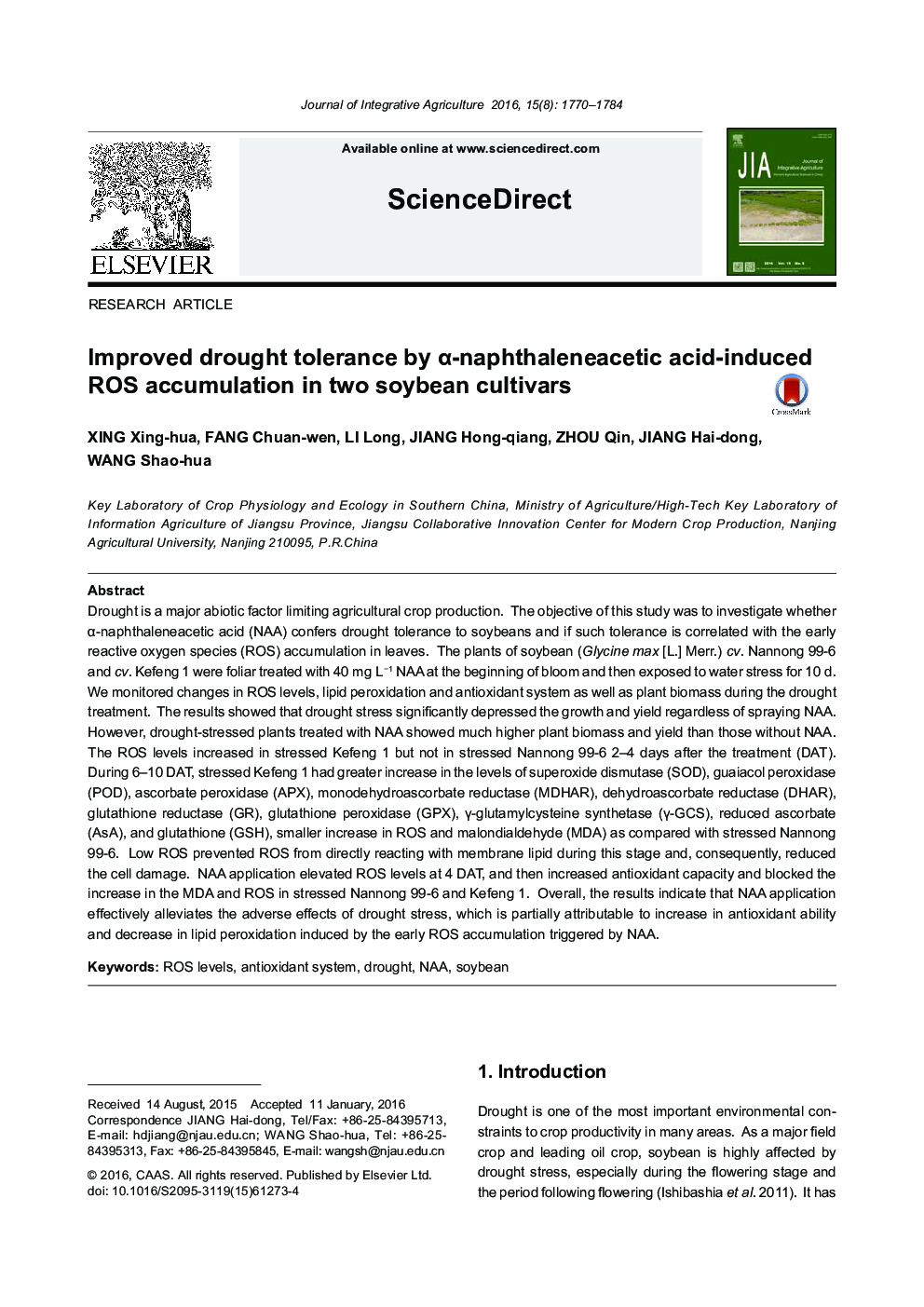| کد مقاله | کد نشریه | سال انتشار | مقاله انگلیسی | نسخه تمام متن |
|---|---|---|---|---|
| 10179927 | 1318694 | 2016 | 15 صفحه PDF | دانلود رایگان |
عنوان انگلیسی مقاله ISI
Improved drought tolerance by α-naphthaleneacetic acid-induced ROS accumulation in two soybean cultivars
دانلود مقاله + سفارش ترجمه
دانلود مقاله ISI انگلیسی
رایگان برای ایرانیان
موضوعات مرتبط
علوم زیستی و بیوفناوری
علوم کشاورزی و بیولوژیک
علوم کشاورزی و بیولوژیک (عمومی)
پیش نمایش صفحه اول مقاله

چکیده انگلیسی
Drought is a major abiotic factor limiting agricultural crop production. The objective of this study was to investigate whether α-naphthaleneacetic acid (NAA) confers drought tolerance to soybeans and if such tolerance is correlated with the early reactive oxygen species (ROS) accumulation in leaves. The plants of soybean (Glycine max [L.] Merr.) cv. Nannong 99-6 and cv. Kefeng 1 were foliar treated with 40 mg Lâ1 NAA at the beginning of bloom and then exposed to water stress for 10 d. We monitored changes in ROS levels, lipid peroxidation and antioxidant system as well as plant biomass during the drought treatment. The results showed that drought stress significantly depressed the growth and yield regardless of spraying NAA. However, drought-stressed plants treated with NAA showed much higher plant biomass and yield than those without NAA. The ROS levels increased in stressed Kefeng 1 but not in stressed Nannong 99-6 2-4 days after the treatment (DAT). During 6-10 DAT, stressed Kefeng 1 had greater increase in the levels of superoxide dismutase (SOD), guaiacol peroxidase (POD), ascorbate peroxidase (APX), monodehydroascorbate reductase (MDHAR), dehydroascorbate reductase (DHAR), glutathione reductase (GR), glutathione peroxidase (GPX), γ-glutamylcysteine synthetase (γ-GCS), reduced ascorbate (AsA), and glutathione (GSH), smaller increase in ROS and malondialdehyde (MDA) as compared with stressed Nannong 99-6. Low ROS prevented ROS from directly reacting with membrane lipid during this stage and, consequently, reduced the cell damage. NAA application elevated ROS levels at 4 DAT, and then increased antioxidant capacity and blocked the increase in the MDA and ROS in stressed Nannong 99-6 and Kefeng 1. Overall, the results indicate that NAA application effectively alleviates the adverse effects of drought stress, which is partially attributable to increase in antioxidant ability and decrease in lipid peroxidation induced by the early ROS accumulation triggered by NAA.
ناشر
Database: Elsevier - ScienceDirect (ساینس دایرکت)
Journal: Journal of Integrative Agriculture - Volume 15, Issue 8, August 2016, Pages 1770-1784
Journal: Journal of Integrative Agriculture - Volume 15, Issue 8, August 2016, Pages 1770-1784
نویسندگان
Xing-hua XING, Chuan-wen FANG, Long LI, Hong-qiang JIANG, Qin ZHOU, Hai-dong JIANG, Shao-hua WANG,